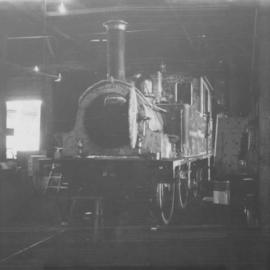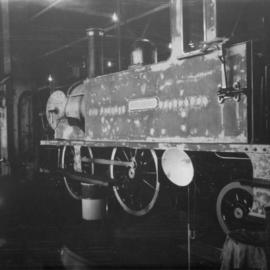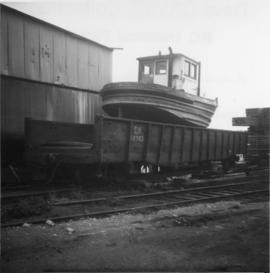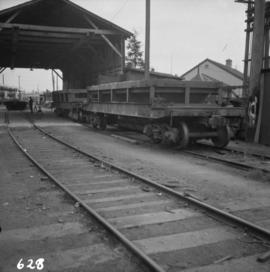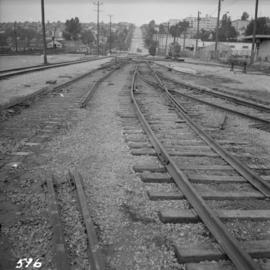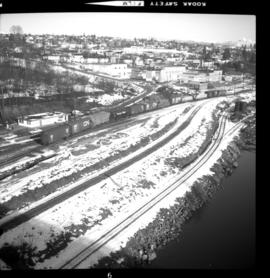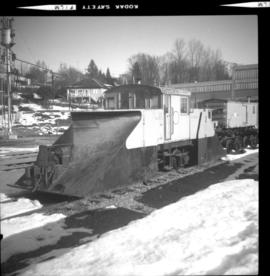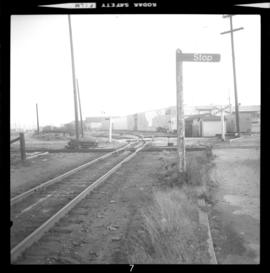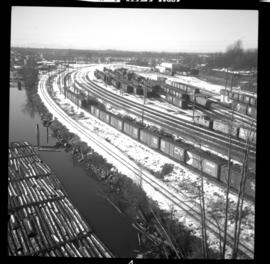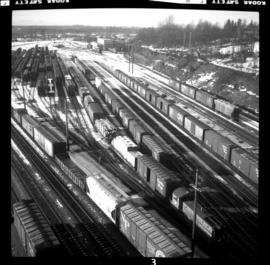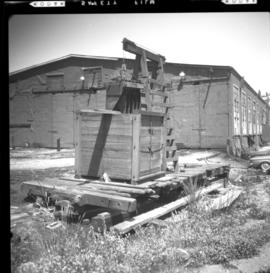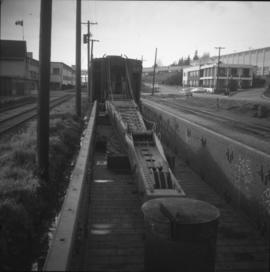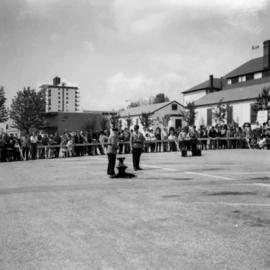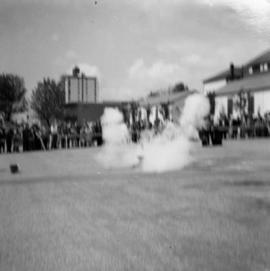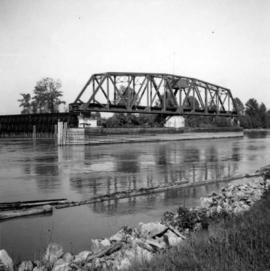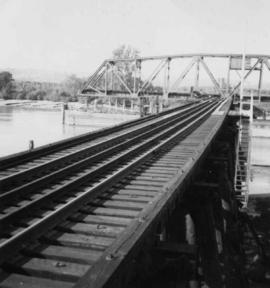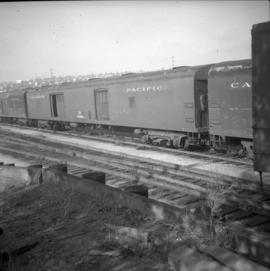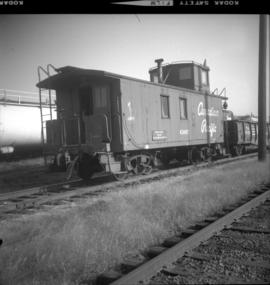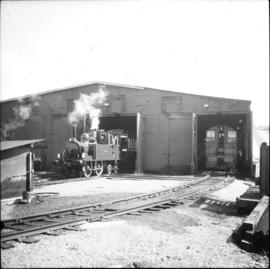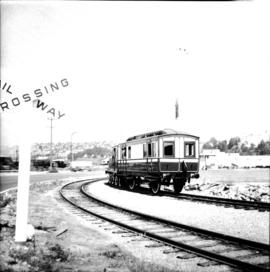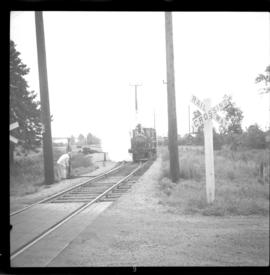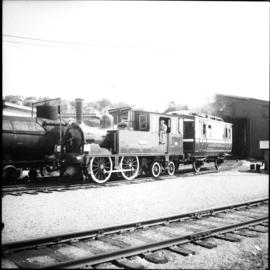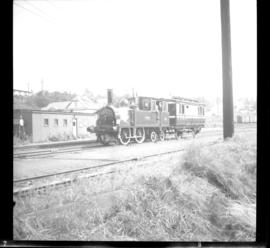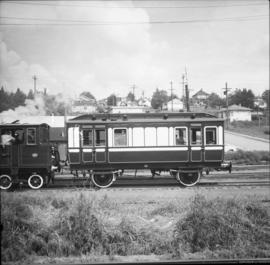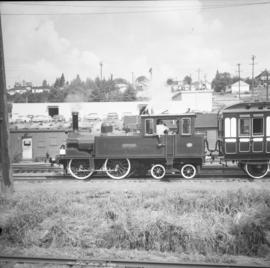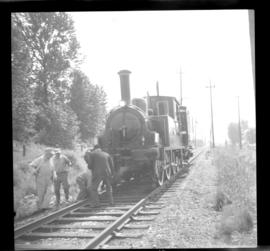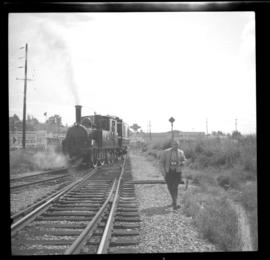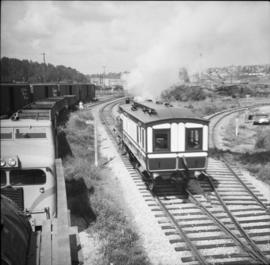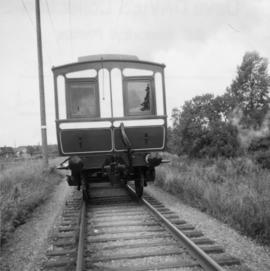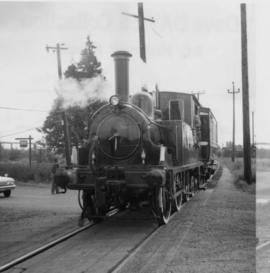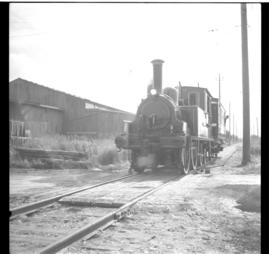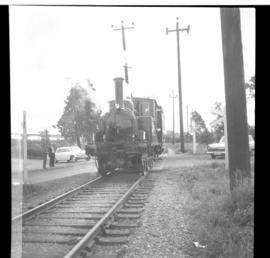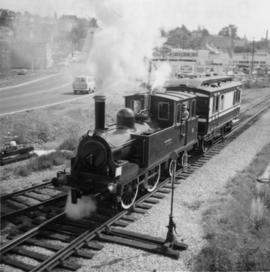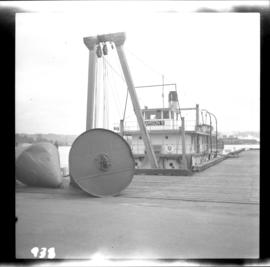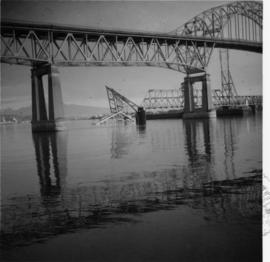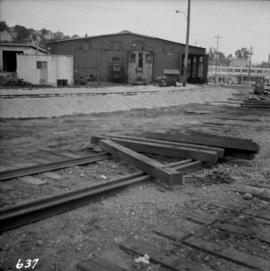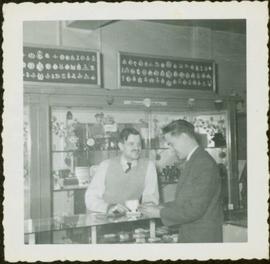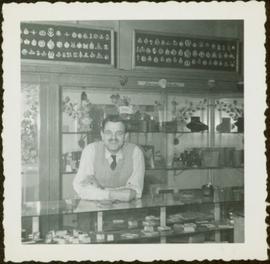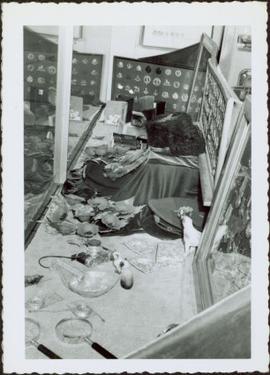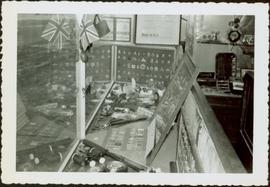Photograph depicts the 0-4-4 "Dunrobin" locomotive in the B.C. Electric Railway locomotive shed in New Westminster. The front buffer beam has been removed, exposing 2 inside cylinders 13x18". Total weight = 25 1/4 tons. Working pressure = 150 lb./sq. inch. Coupled wheels= 4'6" diameter, bogie wheels = 2'6". It was built by Sharp, Stewart, & Co. Ltd. in 1895 at Atlas Works, Glasgow and formerly owned by the Duke of Sutherland. It was steamed for the first time in B.C. on Tuesday, 19th April 1966, and probably for the first time in 2 years.
Photograph depicts a 0-4-4 "Dunrobin" locomotive built by Sharp, Stewart, & Co. Ltd. in 1895 at Atlas Works, Glasgow and formerly owned by the Duke of Sutherland. It was taken inside the B.C. Electric Railway locomotive shed at New Westminster where it was receiving a check-over for steam running and a paint job. The cover to steam dome has been removed.
Photograph depicts a boom tug called "Atlas Captain" that was brought in for refitting, adjacent to a smalll boat repair yard. It was loaded on a CN gondola car and then removed by a derrick crane.
Photograph depicts a ballast wagon awaiting demolition at repair shed of the B.C. Electric Railway in New Westminster. The car was built in 1948.
Photograph depicts B.C. Electric Railway trackage being removed to approaches of locomotive house in New Westminster. The view is looking northeast, probably up 14th St.
Photograph taken at the east end of the BC Hydro Railway yards in Queensborough, looking north east from the bridge in New Westminster.
Photograph taken at the BC Hydro Railway yards in Queensborough, New Westminster. Visible is a snow plough that was mounted on a former steeple cab electric locomotive.
Photograph depicts a cross over. Track on the left to right are owned by the BC Hydro Railway, with the tracks on the right going to the Queensborough rail bridge. The tracks receding into the background are believed to be owned by the CPR.
Photograph taken at the BC Hydro Railway yards in Queensborough, New Westminster.
Photograph depicts recently closed B.C. Hydro Railway locomotive sheds. These are also examples of B.C. Electric Railway car barns.
Photograph taken at the BC Hydro Railway yards in Queensborough.
Photograph depicts former BC Electric car barns in New Westminster. In the foreground remained an old flat and possibly a hoist for battery plates.
Photograph depicts a steam crane with a jib in a gondola car. It is en route to an iron works in Burnaby.
Photograph depicts a fitter examing the condition and safety of an old steam crane en route to an iron works in Burnaby, possibly Coast Steel Fabricator Ltd.
Photograph depicts the city hall at New Westminster on Victoria Day. The anvil battery is about to fire a 21 gun salute.
Photograph depicts the city hall at New Westminster on Victoria Day. The anvil battery firing round #3 of 21 gun salute.
Photograph depicts a C.N.R. swing bridge over the north arm of the Fraser River, approximately 5 miles southeast of New Westminster, looking northeast.
Photograph depicts a C.N.R. swing bridge over the north arm of the Fraser River, approximately 5 miles southeast of New Westminster, looking north.
Photograph depicts the C.N.R. rail swing bridge on the north arm of the Fraser River, approximately 5 miles southeast of New Westminster, looking north.
Photograph depicts CP rail interchange yards about 1/2 mile west of the city center of New Westminster. In the view is CP baggage car #272046 made by the Canadian Car Co. It is now in use as a horse box with end loading.
Photograph depicts a CPR caboose #436917 in New Westminster. It is all wood and was built in 1928. It was lettered "Rubbish service between New Westminster and Coquitlam." A crewman said it was quiet running compared to modern all metal ones.
Photograph depicts a British locomotive, the "Dunrobin," as well as a saloon coach found at a BCER locomotive shed. It was emerging for a second trial run to Steveston. It just underwent a complete overhaul in 1966 after being being purchased by the provincial government of British Columbia.
Photograph depicts a British locomitive, the "Dunrobin," and saloon coach having just emerged from a BCER locomotive shed in New Westminster. Mr. Swanson, a B.C. chief mechanical engineer, is visibled leaning out of the coach's window.
Photograph depicts a British locomotive, the "Dunrobin, " and a saloon coach on BCER track in New West Minster, facing Marpole. The locomotive had stopped and was waiting for the loop switch to be turned.
Photograph depicts a British locomotive, the "Dunrobin," as well as a saloon coach found at a BCER locomotive shed. It was emerging for a second trial run to Steveston. It just underwent a complete overhaul in 1966 after being being purchased by the provincial government of British Columbia.
Photograph depicts a British locomotive, the "Dunrobin" and saloon coach that had just been given the clearance for the run to Marpole and then to Steveston. Visible is BCER track in New Westminster beside the Rayonier lumber mill that was since destroyed by fire in 1966.
Photograph depicts a British locomotive, the "Dunrobin, " and a saloon coach on a test run between New Westminster and Steveston on BCER track beside the Rayonier lumber mill (which was consumed by fire in 1966).
Photograph depicts a British locomotive, the "Dunrobin," and a saloon coach. The locomotive was on a test run between New Westminster and Steveston on BCER track beside the Rayonier lumber mill that had since been consumed by a fire. As part of its recent overhaul, automatic couplings were fitted in the front of the locomotive and at the rear of the coach. A bell was also placed under the main frame and lamps as well as a generator were added.
Photograph depicts a British locomotive, the "Dunrobin" and a saloon coach on a test run at the BCER track between New Westminster and Steveston. It had just underwent an overhaul. Rear view of the coach is on BCER track between New Westminster and Marpole.
Photograph depicts a British locomotive, the "Dunrobin, " and a saloon coach on BCER track in New Westminster. It was on its second steaming trial since the 1940's.
Photograph depicts a British locomotive, the "Dunrobin," and a saloon coach. The locomotive was about to start a roundtrip to Steveston via Marpole on the BCER track in order to test steaming, bearings, running time, and water consumption. It was its second steaming as it had underwent an overhaul in 1966 not since done until 1940's in the U.K.
Photograph depicts a British locomotive, the "Dunrobin" and a saloon coach on a test run at the BCER track between New Westminster and Marpole. The train was forced to stop because of working going on along the line 200 yards behind the camera.
Photograph depicts a British locomotive, the "Dunrobin, " and a saloon coach beginning a test run on BCER track between New West Minster and Marpole.
Photograph depicts a British locomotive, the "Dunrobin, " and a saloon coach beginning a test run on BCER track between New West Minster and Marpole.
Photograph depicts a British locomotive, the "Dunrobin, " and a saloon coach beginning a test run on BCER track between New West Minster and Marpole.
Photograph depicts a British locomotive, the "Dunrobin, " and a saloon coach on BCER track in New Westminster. It was on its second steaming trial since the 1940's after it had underwent a complete overhaul at the BCER locomotive shed in New Westmintster in 1966. "Dunbrobin" en route to Steveston via Marpole.
Photograph depicts the federal government paddle steam sternwheeler "Samson V" at New Westminster. It is used daily on the Fraser River to lift and move buoys etc. It was built in 1937 at New Westminster. It operates between the mouth of the Fraser and Mission. Its crew of 10 is made up of a captain, mate, bosun, two deckhands, cook, steward, chief engineer, greaser, and engineer. It is kept in excellent shape, inside and out.
Photograph depicts the stern wheel of the federal government steamer "Samson V," tied up at New Westminster.
Photograph depicts the federal government paddle steam sternwheeler "Samson V" at New Westminster. The boiler room is the fore part of the lower deck.
Photograph depicts the Federal Railway Bridge in New Westminster. Its span had been knocked down by an unmanned scow. New span was to be floated in on by April 22, 1976.
Photograph depicts the Federal Railway Bridge in New Westminster. It had been knocked down by a runaway scow. The new span was to be built and installed by April 22, 1976.
Photograph depicts a former car barn of the B.C. Electric Railway at New Westminster. Newly aligned track to doors (from left) #3 and #5.
Photograph depicts Great Northern Railway freight heading south having just come off of the New Westminster government rail bridge.
Photograph depicts a Great Northern Railway freight train travelling south over trestle at the south end of a New Westminster rail bridge, at the point where the Great Northern Railway tracks swings westward.
Photograph depicts James Joseph Claxton’s framed badge collection visible on the wall behind the store counter. Handwritten annotation on verso reads: “Part of JJC’s Collection of badges 1954 Rodericks’ Jeweler’s New West.”
Photograph depicts James Joseph Claxton is leaning on the on the store counter with his framed badge collection is visible on the wall behind him. Handwritten annotation on verso reads: “Part of JJC’s badge collection. Roderick Jewelers N. West 1954.”
Collection consists of 140 photographs pertaining to the life and pursuits of James Joseph Claxton over the course of sixty years. Subject areas identified within this collection include: quartz and placer mining in the Cariboo; Kingcome Village; the Royal Irish Contabulary; Roderick's Jewelers, New Westminster; the "M.S. Columbia III"; Kwakiutl petrographs in Fort Rupert; totem poles at Alert Bay; and the Salmon Arm Boy Scouts of Canada group.
Claxton, James JosephPhotograph depicts four frames of James Joseph Claxton's military badge collection in a window display with ceramics, magnifying glasses, and military hats included in the window case. Handwritten annotation on verso reads: “Nov 11th Window 1951 Roderick Jewellers Part of JJC’s badge collection.”
Photograph depicts a window display at Roderick Jewelers with military badges and medals on display in the case. Handwritten annotation on verso reads: “Roderick Jewellers 1951 Nov 11th window. Part of JJC’s badge collection.”
This file consists of 79 photographs, various postcards and Christmas cards from the Royal Irish Constabulary; “Old Hand remembers early days” (unidentified newspaper article re: Burnaby detachment of BC Provincial Police); and a magazine clipping featuring a group photo of “Officers of the B.C. Police, April 1930.” General subjects areas identified in the photographs include: Toc H (Kelowna); the Royal Irish Constabulary; the British Columbia Provincial Police; the Royal Canadian Mounted Police; 1945 liberation parade in Amsterdam, Holland; various historical regimental artworks; badges, helmets, ornaments, banners and related constabulary ephemera; and Claxton in his New Westminster store "Roderick Jewelers" with his extensive collection of constabulary related materials.
